Description and characteristics of the Aleshenkin grape variety, pruning, planting and care
Even a novice gardener can handle the cultivation of grapes Aleshenkin. The variety is unpretentious, withstands severe frosts, therefore it is grown in Russia, where the climate does not differ in a consistently warm summer. Large bunches with tasty berries are formed when optimal conditions for the development of culture are created. Grooming involves proper watering, fertilization, pruning and treatment from infections and pests.
Breeding history
Aleshenkin grapes (Aleshenkin's gift) in the middle of the 20th century in Volgograd were bred by the scientist-breeder P.E. Tsekhmistrenko. He lived and worked in this city, where winters are cold, and the air temperature drops to -25 degrees. The scientist gave the name to the variety in honor of his grandson. A new grape variety was obtained as a result of crossing the Vostok and Madeleine Angevin varieties. The hybrid tolerates frost well, preserving the yield and fruit taste.
Initially, the variety was grown only in the southern regions, and gradually became widespread in northern latitudes. If the conditions are created, it will be possible to get a harvest on the land plots of the Moscow region.
Description of the variety
The purpose of creating a new variety was to increase the yield and improve the taste of berries. Description of the Aleshenka grape variety is not complete without mentioning the main characteristics:
- vigorous vine, bears fruit for 6 years;
- branches are powerful, therefore they can withstand any load;
- bisexual flowers are formed on the shoots;
- the variety can withstand frosts down to -25 degrees;
- berries are suitable for long-distance transportation;
- early borders of crop ripening (approximately 114 days after the formation of ovaries);
- ripe berries begin to pick at the end of July, their color is yellow-green, with a slight bloom, and black is also found;
- high yield allows to collect up to 26 kg of harvest from one grape bush.
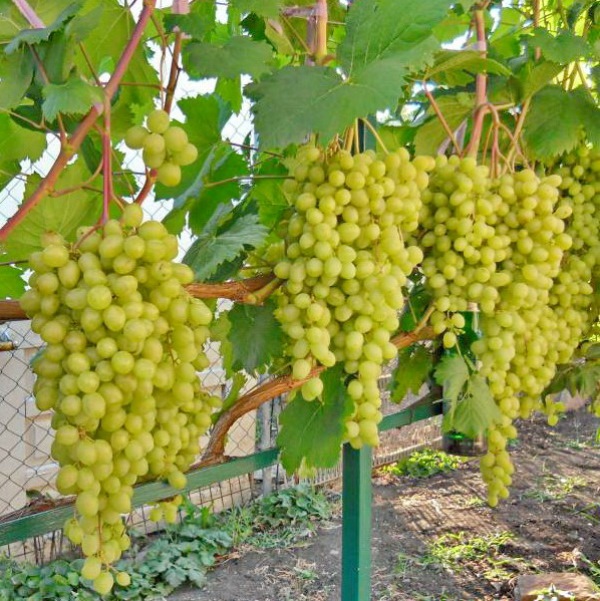
Only the ground part of the Aleshenkin Dar variety can withstand frosts, the root system needs to be insulated for the winter period.
Distinctive characteristics
The variety can be distinguished from other varieties of grapes by the following characteristics:
- leaves are small, smooth, with carved edges, their color is deep green;
- cone-shaped clusters are formed in large sizes, weighing about 650 g;
- oval berries are loosely located in a bunch of grapes, each of them weighs up to 6 g;
- almost half of the berries have no seeds inside.
The pulp of the berries is loose, very sweet and juicy. The sugar content of the variety reaches 19%. Various drinks are made from them.
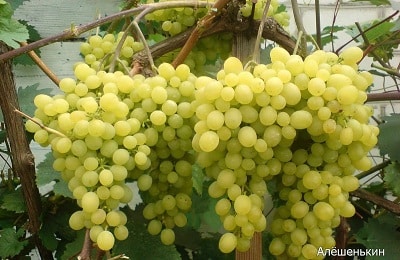
Advantages and disadvantages
The main advantages of the Aleshenkin variety include:
- numerous productivity;
- early ripening of berries under any conditions;
- pleasant taste and lack of seeds;
- the variety adapts quickly after planting.
The Aleshenkin grapes also have weaknesses:
- The roots of grapes do not tolerate frost, therefore, it is recommended to cover the plant for the winter months.
- The berries can become small, so it is recommended to treat crops with growth stimulants and to carry out additional pollination of flowers by hand.
- The cultivar shows poor resistance to fungal infections.
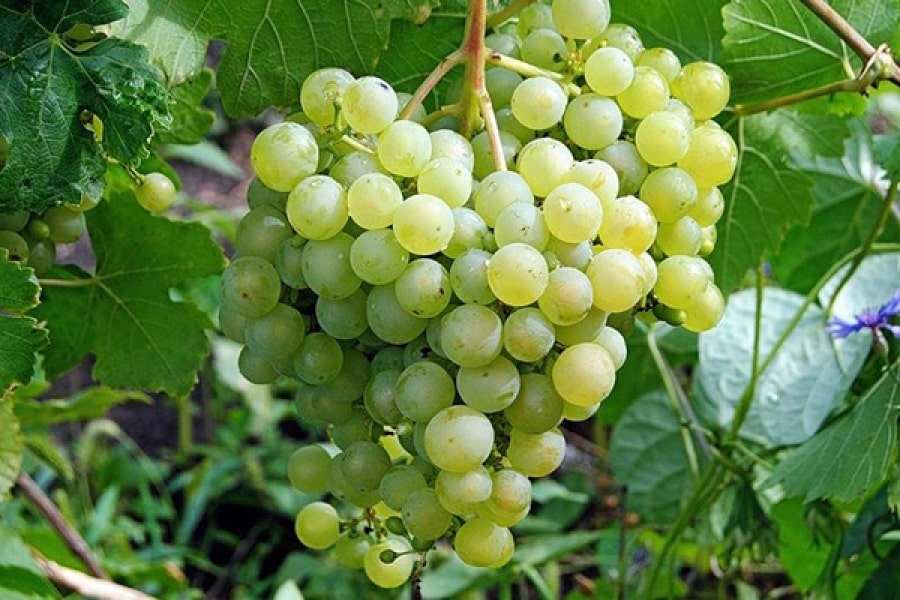
In order not to have problems with the cultivation of the Aleshenkin variety, you must follow the rules and recommendations for planting, soil selection. It is important to provide proper care.
Planting grapes Aleshenkin
The Aleshenkin grape is an unpretentious crop, but in order to harvest a large crop for many years, a number of requirements must be observed. On the site, you need to choose places that are free for access to sunlight. It is better to plant near buildings that will protect the plant from through winds.
The soil should be fertile, light, with neutral acidity. If the soil is acidic, liming is carried out.
An important step is the selection of a quality seedling:
- If seedlings with an open root system are bought, then attention is paid to its color. The lighter the branches, the better. You can determine the freshness of the shoots by the color of the cut. If the roots are dark in color, then the product is not of high quality.
- Healthy shoots are brown, but the cut is light.
- The leaves that remain on the cutting should be even and smooth. In the presence of irregularities and growths, it is worth suspecting the presence of infection or pests.
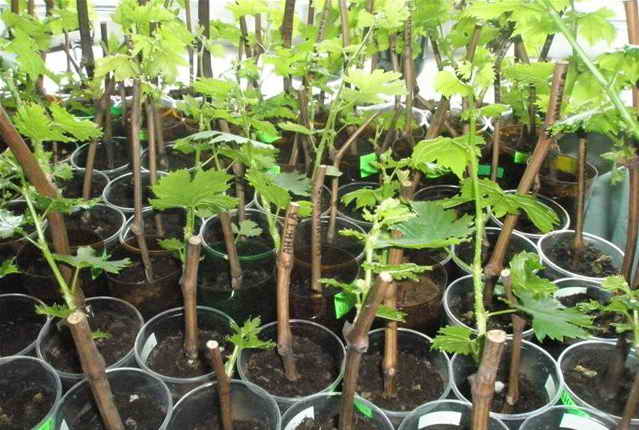
12-14 days before planting grapes the land plot is being dug up. It is best to start planting in the spring, so that the plant has time to get used to and take root:
- Pits are pre-dug with a depth and width of 65-75 cm at a distance of at least one meter.
- At the bottom of each dug hole, drainage is installed, for example, from crushed stone or expanded clay. In the case of a close passage of groundwater, the drainage layer is made up to 25 cm.
- Then fertilizers are added for additional nutrition of the young seedling. After that, a layer of earth is covered and watered with warm water.
A stalk is planted in a prepared hole and a support is installed, sprinkled with earth, slightly compacted and watered again. After three days, watering is repeated. Then mulching is carried out. A layer of mulch (moss, straw, dry leaves, sawdust are chosen as mulch) will not allow moisture to evaporate quickly.

Care Tips
Caring for the Aleshenkin grape consists in proper watering, loosening and weeding the soil around each bush, processing from pests and diseases. Apart from these points, the most basic requirement is the pruning of the vine.
Watering
Immediately after planting the seedling, watering is carried out every two weeks, relying on 4 liters of warm water for each root. Waterlogging of the soil should not be allowed, otherwise root decay will begin.
Fertilization
If fertilizers were applied during planting, then the stock will be enough for the coming years. Grapes are good for organic and mineral components. Solutions based on humus, mullein, wood ash, superphosphate, potassium salt are suitable. Fertilizers should be applied in the spring before flowering and during the formation of ovaries.
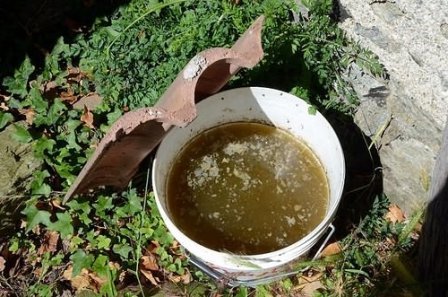
In the spring, as soon as the shelter is removed, a support is installed near the young seedling and the vine is tied up. The first feeding is carried out before the buds appear. It is recommended to use a solution based on chicken manure. The component is mixed with water in a 1: 2 ratio and left to infuse for a week.
Before use, dilute with water in a ratio of 1:10. The resulting solution is poured into a groove specially dug around the barrel. To improve the taste of berries, potash fertilizers are recommended. A lot of potassium is found in wood ash. It can be applied dry, in which case the consumption is equal to one bucket for each root. An infusion is made on the basis of wood ash. Ash is poured with water and insisted for three days.
Formation
The formation of a bush is necessary to increase yields and good development of vines. Before fruiting, each branch is pruned to 14-16 buds. The vine that was harvested last year is cut to the 3rd bud. Each bush should have 40 eyes. Every spring, before the buds begin to swell, they begin to remove dry, damaged branches. They slow down the development of the bush and absorb nutrients.

Shelter for the winter
In order for the grapes to winter successfully, you need to prepare. Lianas are removed from the support, tied, bent to the ground and covered with a film. All actions are carried out in dry, clear weather in mid-October, early November.
If the air temperature is more than 0 degrees, a greenhouse effect will be created inside the shelter, which has a bad effect on the condition of the plant. The film is covered with earth and mulched.
Reproduction methods
Aleshenkin grapes are propagated in three ways:
- The seeds are grown only for industrial purposes. Grapes grown from seeds lose their original characteristics. To improve the quality, it is necessary to plant the vine. This process pushes back the timing of the onset of fruiting.
- The easiest way to propagate the variety is by cuttings. Grapes have to be pruned every year to control their growth. Therefore, there are young shoots that are used for planting. For the plant to take root, there must be at least four buds on each cuttings. Before planting, each cutting is disinfected with copper sulfate.
- By layering, reproduction is carried out in the spring, when there is an active growth of branches. The largest lash is buried in earth, after which it is watered with growth stimulants. Full rooting occurs in 3-4 weeks.
When creating good conditions and observing all the requirements for care, cuttings and layering of grapes begin to bear fruit after a couple of years.
About diseases and pests
The Aleshenkin grape variety is attacked by pests and is not resistant to major infections. Dangerous pests for the Aleshenkin grape variety are: grape mite, marble beetle. Of the diseases, the plant is most often infected with mildew, oidium. Experienced summer residents recommend, for preventive purposes, twice a year (preferably in June and July) to treat grapes with solutions based on such drugs as Topaz, Horus, Ridomil Gold, Stroviy, Fufanon.
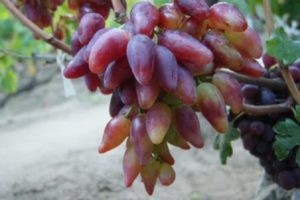
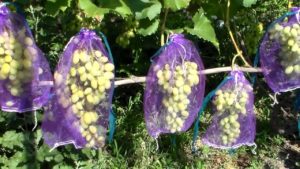


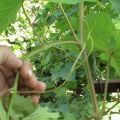
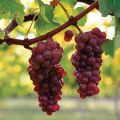

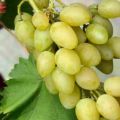
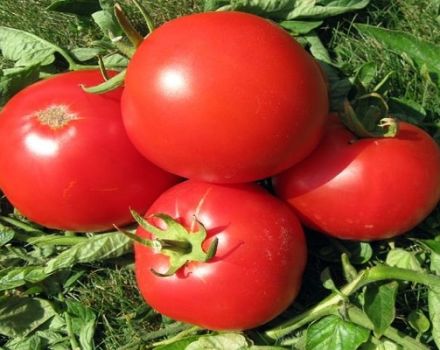
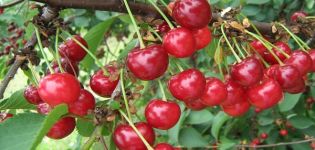
Several years ago I planted several bushes - the variety is excellent, really unpretentious and very productive. But I noticed that the yield increased significantly when I started to feed Biogrow.